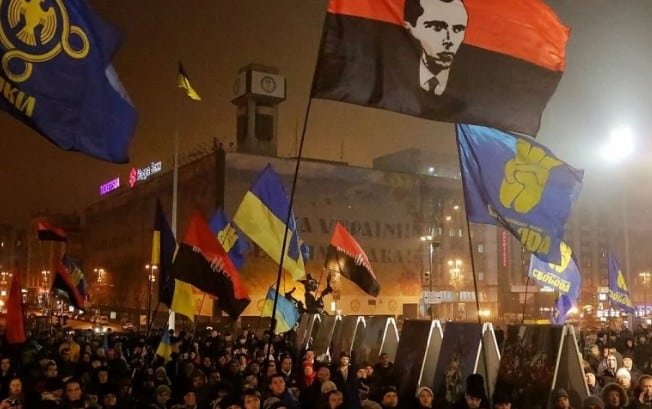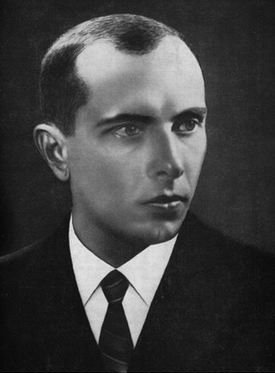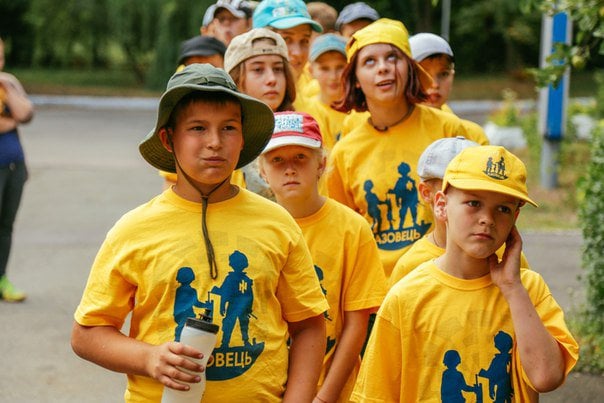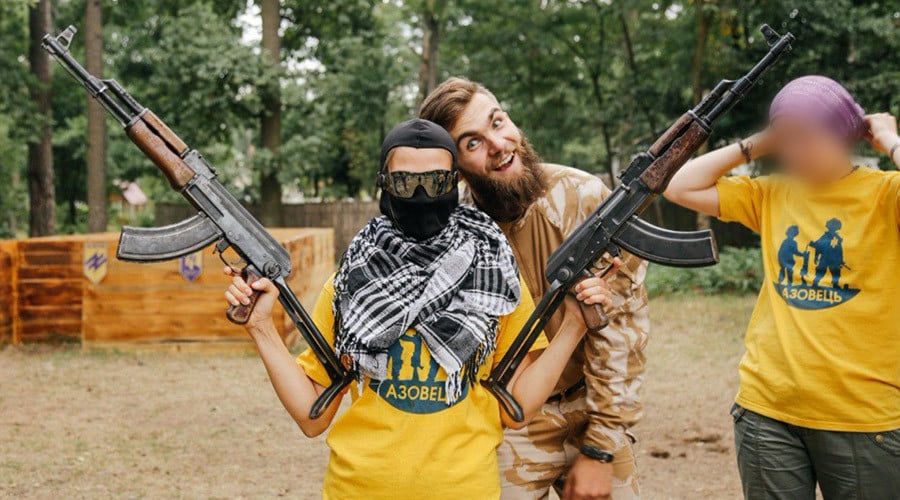
Liberation News – On February 24, Russian President Vladimir Putin undertook what he referred to as a “special military operation … to de-militarise and de-Nazify Ukraine.” Western media immediately decried these stated goals, regularly repeating that the allegations of Nazism in Ukraine are nothing more than Russian “fake news.”
Former U.S. ambassador to Russia, Michael McFaul, went so far as to flatly state that “there are no Nazis in Ukraine.” Similar claims resound throughout the mass media’s echo chambers, and the fact that the current president of Ukraine is Jewish is often short-sightedly presented as the only “proof” necessary.
Disputing the existence of Nazis and fascists in Ukraine serves the purpose of constructing a twisted but simplistic narrative loosely based on WWII: Putin is an evil, Hitler-like figure intent on attacking the freedom-loving Ukrainian government and its innocent supporters. The goal of such a narrative is to foster blind and unquestioning support for the Zelenskyy government, NATO, and the imperialist Western powers.
A “humanitarian” war, meaning a brutal NATO intervention that would likely spark WWIII, is thereby presented as a viable option. In this context, any attempt to provide a sober and concrete analysis of the actual history of Nazism in the region runs the risk of being disingenuously labeled and dismissed as “pro-Putin” because it does not support this war-mongering narrative.
But an examination that accounts for the complexities of concrete situations reveals that there is indeed a deep and expansive history of fascism in Ukraine, which has been aided and abetted by the US government. This does not however mean that fascism is necessarily the dominant force in the country or even in every domain in which it exists (the military, paramilitary forces, the parliament, society at large, etc.). Moreover, it does not imply in the least that one has to support Russia’s invasion, or even assume that ‘denazification’ is its primary goal. On the contrary, it is possible to understand that fascism is a very real force in Ukraine while opposing Putin’s decision to deploy troops.
A brief history of Nazis, NATO and Ukraine
To understand the current conflict, it is important to recall that Russians and Ukrainians once lived in relative harmony, when they were both part of the Union of Soviet Socialist Republics, which was founded on the principle of the self-determination of nations. This was violently interrupted in 1941, when the Nazis invaded the USSR, taking over much of Ukraine.
According to John-Paul Himka, a quarter of all victims of the Holocaust lived in Ukraine, and Ukrainian ultra-nationalists collaborated with the Nazis in carrying out their horrendous deeds. The Organization of Ukrainian Nationalists (OUN) and its armed force, the Ukrainian Insurgent Army (Ukrainska povstanska armiia—UPA) participated in this genocidal rampage: “OUN militias were key actors in the anti-Jewish violence of summer 1941; OUN recruited for and infiltrated police formations that provided indispensable manpower for the Germans’ mobile killing units; and in 1943, thousands of these policemen deserted from German service to join the OUN-led nationalist insurgency, during which UPA killed Jews who had managed to survive the major liquidations of 1942.” According to Ian Sayer and Douglas Botting, “the OUN played a significant part in the extermination of the Jews and other ‘undesirables,’ often performing the dirty work of the German Einsatzkommando extermination squads (eg the killing of children), and continuing after the war under American sponsorship.”

Indeed, in the postwar era, the U.S. government discreetly integrated an alarming number of Nazi collaborators into a veritable international network of anti-communist fascists. By 1952, John Loftus estimates that there were “hundreds if not thousands of important Nazi collaborators from Byelorussia, Ukraine, the Baltic states, and the Balkans” who had been brought to the United States (and many more had been operationalized around the world). The US Counter-Intelligence Core (CIC) ran operation Any face to protect the fascist leader of the OUN–the renowned Nazi collaborator Stepan Bandera–from being brought to justice by the Soviets. Bandera’s chief of the national security service (SB), Mykola Lebed, was “the highest-ranking Ukrainian Nazi to ever enter the United States.” CIA covert operations chief Frank Wisner admitted in 1951 there were “at least twenty former or active members of the SB of OUN/Bandera in the United States.”
The US intelligence services worked closely with several organizations of former Nazi collaborators like these in order to run extensive sabotage, terror and assassination campaigns against the USSR. In 1951, Wisner estimated that “over 35,000 members of the Russian secret police (MVD-MKGB) have been killed by OUN-UPA since the end of the last war.”
NATO was deeply involved in this anti-communist war, as demonstrated perhaps most clearly by Operation Gladio. Overseen by the CIA and MI6, NATO established a large secret army of trained militants, many of whom were well-established Nazis and fascists. According to the official Italian Senate investigation into Gladio:
“It emerges without the shadow of a doubt that elements of the CIA started in the second half of the 1960s a massive operation in order to counter by the use of all means the spreading of groups and movements of the left on a European level.”
This included targeted killings and false flag terrorist attacks that were blamed on communists in order to terrify the civilian population into supporting right-wing governments and anti-communist raids.
The Supreme Allied Commander Europe of NATO from 1963 to 1969 was Lyman Lemnitzer, who had given the green light to Operation Northwoods in 1962. This operation, which was never implemented because President John F. Kennedy refused to sign off on it, consisted of planning false flag terrorist attacks against U.S. citizens that would be blamed on Cuba in order to justify a military invasion of the island.
Lemnitzer’s tenure overlapped with Adolf Heusinger’s, one of the many high-ranking Nazi and fascist officials who had been integrated into U.S. military and intelligence networks. Heusinger served as Hitler’s Chief of the General Staff of the Army and later became Chairman of the NATO Military Committee (1961-1964). NATO did not content itself, then, with having Nazis do some of its dirty work by recruiting them into its secret armies to run heinous anti-communist terrorist campaigns. It also integrated them directly into its leadership, thereby sending a clear message to the world regarding its political orientation.
The Maidan Coup
In the ensuing years, the United States continued to work with Ukrainian fascists in their endless destabilization campaigns against the USSR. According to CIA specialist Douglas Valentine, “the CIA has been developing fascist assets in Ukraine for 70 years.”
The Maidan coup in late 2013-2014, which was openly supported by the imperial powers in the United States and Europe, relied on far-right shock troops such as the fascist organization Right Sector and the ultranationalist Svoboda Party to overthrow the elected government of Viktor Yanukovych.
Three members of Svoboda were installed as members of the first post-coup government, and the co-founder of Svoboda, Andriy Paruby, was the parliamentary speaker for five years.
Although Svoboda has since attempted to mollify its Nazi image, it maintains its substance as an ultranationalist, anti-communist party that openly praises Nazi collaborator Stepan Bandera, the politician and theorist of the militant wing of the fascist OUN.
The Azov Battalion was formed in May 2014 out of the ultra-nationalist Patriot of Ukraine (founded in 2005) and the Social-National Assembly or SNA (founded in 2008) is “known to have carried out attacks on minority groups.”
The Azov Battalion, Right Sector, and other fascist militias played a key role in consolidating power for the post-coup government in numerous ways: engaging in street violence against the Left, running intimidation campaigns against uncooperative politicians, setting up indoctrination camps for children and youth, and exerting pressure on the government to revise the education curriculum, ban the Russian language, and rewrite official state history. This post-coup period of street violence and intimidation culminated in what some have called the worst Nazi atrocity since WWII, when some 42 leftists perished in an inferno set by fascists in the Odessa trade union building.
This U.S.-backed regime-change operation is what prompted the outbreak of a civil war in the Donbas region of Eastern Ukraine. When pro-Russian separatists declared their independence from the fascist Ukrainian puppet government, it was unable to contain them. So the Azov battalion and other fascist militias were unleashed, leading to the death of some 14,000 people (just before the 2022 invasion, Putin recognized the independence of the two regions of the Donbas). Azov received backing from Ukraine’s interior minister, Arsen Avakov, as well as U.S. arms and training. Due to its purported effectiveness in fighting Russian separatists, the battalion was integrated into the Ukrainian National Guard in 2014, formally becoming part of the state.
In 2015, the CIA, according to five former intelligence and national security officials, set up “a secret intensive training program in the U.S. for elite Ukrainian special operations forces and other intelligence personnel.” The same year, the U.S. Congress passed a spending bill that featured “hundreds of millions of dollars worth of economic and military support for Ukraine, one that was expressly modified to allow that support to flow to the country’s resident neo-Nazi militia, the Azov Regiment.”
Since there has been some debate regarding just how Nazi the Azov or other ultranationalist militias are, it is worth noting that the U.S. House of Representatives acknowledged in 2015 that Azov is “neo-Nazi.” Although the battalion has sometimes denied that it adheres to Nazi ideology as a whole, “Nazi symbols such as the swastika and SS regalia are rife on the uniforms and bodies of Azov members.” Their uniforms carry the neo-Nazi Wolfsangel symbol, which looks like a black swastika on a yellow background. Andriy Diachenko, the spokesperson for the regiment in 2015, claimed that “10% to 20% of the group’s members are Nazis.” It appears that he made this statement in order to downplay fears of Nazification. However, even if the numbers are that low, it necessarily follows that all of the other members of the Azov battalion are Nazi collaborators.
Regardless of whether or not Azov or similar battalions accept 100% of Nazi ideology, it is essential to recognize that their overall orientation is clearly fascist: they receive funding from reactionary elements of the capitalist ruling class to run violent para-state militias–which in some cases have been integrated into the state–that are ultranationalist, racist, pro-capitalist, and anti-communist. Andriy Biletsky is well-positioned to understand their orientation because he served as the leader of the Patriot of Ukraine and the SNA, as well as the Azov Battalion, before serving as a member of the Ukrainian Parliament from 2014-to 2019. In an interview, he explained his position as follows: “The historic mission of our nation in this critical moment is to lead the White Races of the world in a final crusade for their survival. A crusade against the Semite-led Untermenschen [inferior races, according to the standard Nazi terminology].”
Fascism today in Ukraine
In Ukraine today, fascist elements are present in the capitalist ruling class, paramilitary organizations, the Ukrainian military, the parliament, and certain sectors of society. While it would be a mistake to assume that they are in each case the dominant force, it would be equally erroneous to ignore their presence, extensive reach and the support they enjoy from the Zelenskyy government and imperialist forces outside the country.
In the 2019 parliamentary election, Svoboda formed a united party list with other far-right parties: Right Sector, National Corps, and the Governmental Initiative of Yarosh. They only obtained 2.15% of the votes, not surpassing the 5% threshold for a parliamentary seat. In the same election, Volodymyr Zelenskyy’s Servant of the People party, which ran on an anti-corruption platform and is described as centrist in the mainstream press, won 124 seats on the nationwide party list and 130 constituency seats.
Zelenskyy’s party is named after the eponymous hit Ukrainian TV series that appealed to “Ukrainians frustrated with the country’s oligarchic elite, and the failure to drain the swamp after the country’s 2014 revolution.” In the series, Zelenskyy, a career actor and comedian, played the role of none other than the President of Ukraine. His meteoric rise to the actual presidency was thus due in no small part to his celebrity status as a famous actor, not unlike other political puppets in bourgeois democracies. Moreover, he received ample funding from a handful of private donors, including most notably the billionaire oligarch Ihor Kolomoyskyi, who was his single biggest supporter.
Kolomoyskyi owns an ownership stake in 1+1 Media Group, whose TV station carried “Servant of the People,” which retrospectively looks a lot like an extended campaign advertisement. His media outlet also provided security and logistical backup for the actor’s political campaign, during which time he traveled 14 times to Geneva and Tel Aviv, where Kolomoyskyi is based. The Pandora Papers revealed a spider web of offshore networks and financial entanglements between Zelenskyy and Kolomoyskyi.
Kolomoyskyi is, moreover, one of the major funders of the ultranationalist militias in Eastern Ukraine, including the fascist Azov and Aidar battalions, which have been accused of heinous war crimes in the Donbas region over the past eight years. He also allegedly funds “the Donbas, Dnepr 1, Dnepr 2 volunteer battalions.” When he was appointed governor of his home state of Dnipropetrovsk in March 2014, he was instrumental in crushing the separatist movement there by “spending more than $10 million to create the ‘Dnipro battalion.’”
In 2015, it was estimated that there were some 30 nationalist militias fighting separatists in eastern Ukraine. Financially supported by wealthy oligarchs like Kolomoyskyi and Serhiy Taruta (the billionaire governor of the Donetsk region who also funded the Azov battalion), they function as a powerful paramilitary force that supplements the Ukrainian military. In July 2015, Russia issued a warrant for Kolomoyskyi’s arrest for “organizing the killing of civilians” due to his financial support of the militants.
Far from cracking down on these ultranationalist militias, many of which display open signs of Nazism and fascism, Kolomoyskyi’s actor-turned-president has not only allowed them to act with impunity, but he has also woven a tight relationship between his administration and open fascists.
For instance, in November 2021 Dmytro Yarosh, a former leader of Right Sector and an avowed follower of Nazi collaborator Bandera, declared that he had been appointed as an advisor to the Commander-in-Chief of the Armed Forces of Ukraine. Soon thereafter, Zelenskyy decorated Right Sector commander Dmytro Kotsyubaylo with the distinction “Hero of Ukraine.” On March 1 of this year, he appointed Maksym Marchenko, a former commander of the Aidar Battalion – which is accused of war crimes in Donbas – as the regional administrator of Odessa. There are numerous other ties between the Ukrainian government and military, on the one hand, and these ultra-nationalist and often fascist militias on the other.
While they’ve been busy empowering fascists, Ukrainian authorities also stripped communist parties of their right to participate in elections in 2015 and issued controversial ‘decommunization’ laws: “The laws ban the display of Soviet symbols and change the status of the 09 May holiday marking the Soviet victory over Nazi Germany in World War 2. The laws will effectively remove all mentions of ‘the Great Patriotic War’ (a Soviet term for World War 2) and replace it with ‘Second World War’; ban the Soviet Victory flag; and rename streets, squares, and even whole cities.” Tens of thousands of streets have since been renamed, along with nearly one thousand cities and villages. Over two thousand statues and monuments have also been removed in this expansive anti-communist cultural project. Despite widespread criticism, the current government has refused to revoke the laws. According to Abdul Rahman, “Zelensky’s reluctance to take on right-wing groups in the same way that he is targeting allegedly pro-Russian groups is a sign of their influence in setting the political discourse in the country.”
There have also been a number of important symbolic gestures that glorify ultra-nationalists and Nazi collaborators, thereby fostering a broader culture of fascism within certain sectors of Ukrainian society. Zelenskyy claimed in an interview, for instance: “There are indisputable heroes. Stepan Bandera is a hero for a certain part of Ukrainians, and this is a normal and cool thing. He was one of those who defended the freedom of Ukraine.” Zelenskyy also publicly defended Ukrainian footballer Roman Zolzulya as a “true patriot” when he was accused of being a Nazi due to his photos with Nazi collaborator Bandera and his open support of the Azov Battalion. Moreover, Zelenskyy’s former Prime Minister, Oleksiy Honcharuk appeared on stage at a neo-Nazi concert organized by the fascist C14 movement.
It is perhaps not surprising, then, that Ukraine was the only country, along with the United States, which voted against the UN General Assembly’s draft resolution “combating glorification of Nazism, neo-Nazism and other practices that contribute to fueling contemporary forms of racism, racial discrimination, xenophobia and related intolerance.” Important media outlets have broadcast Nazi propaganda, which resound throughout the broader culture. In 2014, a Ukrainian journalist on Hromadske TV openly called for genocide in Donbas, claiming that “there is a certain category of people that must be exterminated.”
On March 13 of this year, Ukrainian TV presenter Fahruddin Sharafmal issued an impassioned call for genocide and the slaughter of Russian children on a morning show on Channel 24. With a photograph of the notorious Nazi Adolf Eichman behind him, he said:
“I allow myself to quote Adolf Eichmann, who said that in order to destroy a nation, you must destroy, first of all, its children. Because if you kill their parents, the children will grow up and take revenge. By killing children, they will never grow up and the nation will disappear.”
“And when I get the chance to take out the Russians,” he went on,
“I will definitely do it. Since you call me a Nazi, I adhere to the doctrine of Adolf Eichmann, and I will do everything in my power to ensure that you and your children never live on this earth. You have to understand that it’s about the victory of the Ukrainian people, not about peace. We need a victory. And if we have to slaughter all your families – I’ll be one of the first to do it.”
Channel 24 is part of the TRK Lux media conglomerate that is controlled by wealthy Ukrainian businesswoman Kateryna Kit-Sadova and her husband Andriy Sadovyi (the mayor of Lviv and former leader of the Self Reliance political party).
Zelenskyy has recently used the Russian invasion as a pretext to ban 11 political parties, including the largest opposition party that holds 43 seats in the parliament, while having communist leaders arrested. Alleging to fight against Russian “misinformation,” he also took control of news outlets, imposing a centralized information policy that combines all national TV channels into “a single information platform of strategic communication.” Ukraine’s Ministry of Foreign Affairs is working directly with an international network of public relations firms to wage information warfare and control the narrative. According to a senior NATO official: “They are really excellent in stratcom [strategic communication] — media, info ops, and also psy-ops.”
Zelenskyy’s experience as a career actor has certainly been an asset in these endeavors. After all, he seeks to depict his government as free and democratic – not unlike the Western imperialist powers it is aligned with – while it supports fascist militias, receives funding from reactionary capitalists (who also fund Nazi battalions), glorifies ultranationalists and Nazi collaborators, emboldens a culture of fascism, bans political parties, and tightly controls news and information.
The fascist threat is international
Although Ukraine might seem to some in the United States or elsewhere to be a distant land with little bearing on one’s immediate political environment, it is actually an important center for the global fascist movement. According to Aljazeera: “Transnational support for Azov has been wide, and Ukraine has emerged as a new hub for the far right across the world. Men from across three continents have been documented to join the Azov training units in order to seek combat experience and engage in similar ideology.” In an investigative report from early 2021, Time found that
“Azov is much more than a militia. It has its own political party; two publishing houses; summer camps for children; and a vigilante force known as the National Militia, which patrols the streets of Ukrainian cities alongside the police […] it also has a military wing with at least two training bases and a vast arsenal of weapons, from drones and armored vehicles to artillery pieces.”
Olena Semenyaka, the head of international outreach for Azov, told the reporters: “It could be described as a small state within a state.”
Ali Soufan has estimated that “more than 17,000 foreign fighters have come to Ukraine over the past six years from 50 countries.” In 2019, U.S. lawmakers wrote a letter to the State Department in which they stated that “the link between Azov and acts of terror in America is clear.” A 2018 FBI affidavit stated that Azov “is believed to have participated in training and radicalizing United States-based white supremacy organizations.” This included members of the white supremacist Rise Above Movement, which were indicted for having “‘violently attacked and assaulted counter-protesters at several white nationalist and white supremacist events throughout the U.S., including the violent ‘Unite the Right rally in Charlottesville.”
Nazism and fascism are very real factors in Ukraine, and they have been extensively documented. Recognizing this fact is essential to have a nuanced understanding of the current conflict, but it does not at all imply support for Putin’s military intervention, which has had horrific consequences for the lives of many innocent workers.
Finally, it should not be lost on us that the Biden administration, which came to power as a purported bulwark against the spread of fascism at home, is continuing the US policy of supporting fascist forces in one of the primary hubs for international fascism. This clearly demonstrates that the struggle against fascism can never be limited to a domestic battle. It must always be carried out within an internationalist framework and thus inseparably linked with resolute anti-imperialism.
Note to readers: Please click the share buttons above or below. Follow us on Instagram, Twitter, and Facebook. Feel free to repost and share widely Global Research articles.
The author expresses his gratitude to Helmut-Harry Loewen for his invaluable suggestions and assistance in locating the best sources on fascism in Ukraine.
Featured image: 2015 march in Kiev to celebrate the birthday of Nazi collaborator Stepan Bandera (pictured on black and red flag) (Source: Liberation News)
The original source of this article is Liberation News
ATTENTION READERS
We See The World From All Sides and Want YOU To Be Fully InformedIn fact, intentional disinformation is a disgraceful scourge in media today. So to assuage any possible errant incorrect information posted herein, we strongly encourage you to seek corroboration from other non-VT sources before forming an educated opinion.
About VT - Policies & Disclosures - Comment Policy





